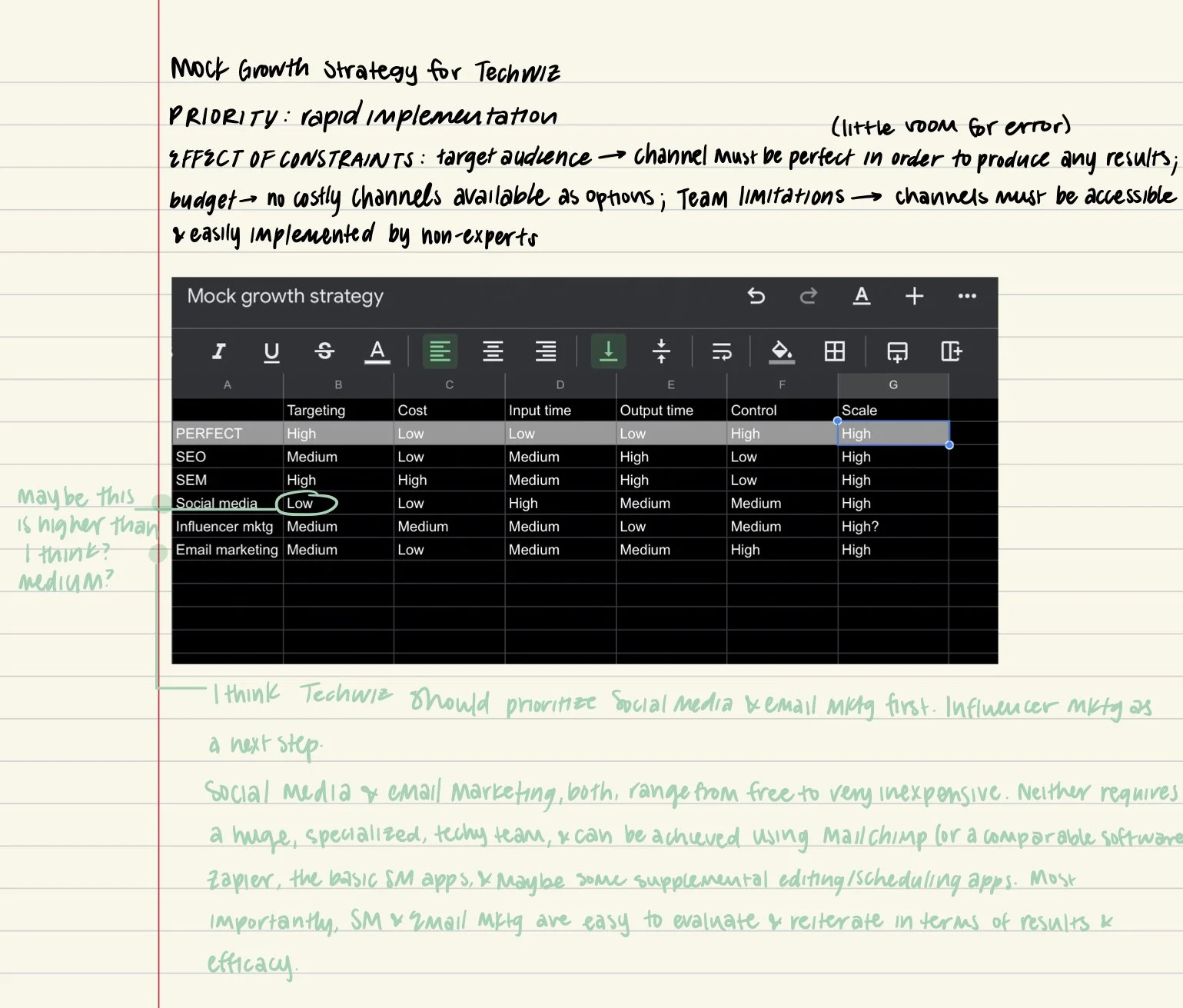I spent a month studying all things growth marketing and analytics. Here’s a recap:
I’ve spent the past 4 weeks studying growth marketing & analytics. I had no prior experience, quite minimal knowledge, and only a few weeks to get it done. Here’s what I learned:
week one
The first week was informational and content-heavy, as most first weeks are. And a large majority of that content came from Wes Wagner (growth expert, entrepreneur, and most importantly, a Hoosier). Most of us (that have a general knowledge surrounding marketing) know that awareness, acquisition, activation, retention, revenue, and referral are the pillars of business growth; the marketing funnel we all know and love. Wagner explains that marketing hones in predominantly on the first two A’s (awareness & acquisition), while growth is a full-funnel focus.
Another point Wagner makes is that growth is all about optimization. He quotes that “growth is about performing experiments to optimize f(x)=y.” If you’re anything like me, it’s been a hot second since you’ve seen that equation. To catch you up: that’s a function. In the context of growth marketing, Y= a metric at the intersection of the value your product provides, and how people pay you. So not necessarily profit, but more so the exchange of value that happens for you to get paid, and your customer to receive value. X= everything you do to obtain Y, within the limits of the marketing funnel (awareness, acquisition, etc.). Growth is simply about optimizing the journey from our efforts to our reward.
Wagner promotes a scrappy, experimental, and highly measurable approach to growth. Within this frame of mind, I completed an exercise where I chose 3 companies and was prompted to define f(x), as well as each stage of the funnel, awareness to referral, for each one. This exercise was highly beneficial to me in terms of understanding all the metrics and terminology I had just learned.
week two
The second week leaned into optimizing retention and acquisition, specifically. I won’t go too deep into that , but here are some notes from Brian Balfour’s (one of the best of the best among the growth experts) lectures on this:
Balfour on Retention
optimization will do nothing for you if you don’t have product/market fit
retention is like playing the long game, but it’s one of your most important metrics
if your retention begins to trend toward zero: SEGMENT: Get to the bottom of each customer’s story/experience
there are 4 parts of retention: new user experience, midterm, longterm, and resurrection.
you must balance permissions and friction with each and every customer/user
Balfour on Acquisition
“shape yourself like a T;” you need multiple layers of skills, at various depths of knowledge: a base layer of non-marketing specific subjects, a basic marketing foundation, and channel expertise
when it comes to choosing channels to go deep on, consider your preference and skills, and then pick two that align; one being an age-old, tried and true channel, and one being an emerging, “risky” channel. This allows for both stability and room for growth
At the end of this week, I performed an exercise to study the retention & acquisition tactics of a company that has held my attention for years on end. I chose Spotify.
week three
This week, we were back with our guy Brian Balfour to study “The Four Fits Framework.” I have a large page of notes for this one, so I’m going to keep it brief. But essentially, Balfour explains that there are four fits that must occur for any product to be successful: Market/product, product/channel, channel/model, and model/market. In that order. And then we got into a lot of other terms like ARPU and CAC, as well as more equations and line graphs and spectrums.
The second part of the week, we heard an optimization lecture with Gustaf Alströmer, where he talked mostly about A/B testing. He was on the OG Airbnb growth team, so he seems pretty qualified.
My project this week was creating a channel matrix for a mock company, and then utilize my findings to draft a growth strategy for them. This strategy was complete with optimization priorities, constraints, the whole nine. Here are some of my notes as I was prepping for that:
week four
The final week! This week was all about learning the RICE framework (reach, impact, confidence, and ease— also sometimes listed as effort), and using that to craft a growth strategy for my business of choice. I chose a company called Demandjump, a local acquisition tool/company I found. I’ve attached my RICE spreadsheet below, but essentially, you score each hypothesis between 1-10 under the four RICE categories that I listed above. Once you input those values, the table calculates a score for each experiment. This creates a quick and easy way to determine the success likelihood (and/or the practicality) of a certain hypothesis you may have. This is something I’m definitely still working to master, but definitely an excellent tool.
wrap it up
This month was certainly a huge learning curve for me, as these concepts certainly are not as intuitive to me as content creation or copywriting. I’m so glad I did it, though! I felt very lost midway through each week, but once I completed the projects, everything clicked a little more.
I’m definitely interested to see all the ways this knowledge will prove useful to me in my future occupation, if I do end up in the marketing scene. Even if I don’t end up anywhere near the growth side of things, I think having this foundation in the technical, analytical side of things will be a huge asset.
Cheers to learning, always!


